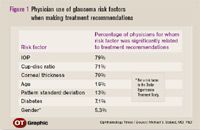Article
Risk calculators improve OH management
Several risk calculators are available to help assess the likelihood that a patient with ocular hypertension will develop glaucoma. The decision to treat then can be based on an individual patient's risk. That determination may be guided by expert opinion, results of decision analysis models, personal experience, and discussion with the patient.

Key Points

Although medical research has generated complex data about a range of diseases and identified significant risk factors, Dr. Boland said, it is difficult for physicians to integrate a multitude of information to guide decision-making for an individual patient. Risk calculators allow clinicians to produce a quantitative risk of disease rather than a qualitative risk assessment. With that information in hand, physicians can be more explicit when talking with their patients. Using a risk calculator also can improve consistency in recommendations, he said.

"This initiative from [the Centers for Medicare and Medicaid Services] will increasingly drive practitioners toward using tools that will help them prove to payers that they are doing the right thing based on available evidence," said Dr. Boland.
Use in clinical practice
Based on risk factors identified in OHTS and the European Glaucoma Prevention Study, several risk calculators are available to estimate risk of progression to glaucoma among patients with ocular hypertension:
To use any of those tools, a clinician first should consider whether his or her patient is similar to subjects in the OHTS with respect to such factors as age and IOP. Then, once the risk is calculated, the physician needs to establish a threshold for intervention. That determination can be guided by the clinician's own experience, authoritative opinion, or formal decision analysis. In a paper published in 2004, Weinreb and colleagues recommended treating patients with ocular hypertension whose risk of converting to glaucoma over 5 years exceeded 15% [Am J Ophthalmol. 2004; 138:458-467].
Decision analysis integrating costs and benefits represents an alternative for identifying a threshold for intervention. That method models the course of the disease and the costs and benefits of treatment and determines the cost-effectiveness of treatment at various risk levels. In a risk model analysis reported by Kymes et al. in 2006, a >10% risk of converting to glaucoma over 5 years represented the cutoff for where treatment became cost effective [Am J Ophthalmol. 2006;141:997-1008].
The final step in determining whether to initiate treatment still involves a one-on-one discussion with the patient.
Newsletter
Don’t miss out—get Ophthalmology Times updates on the latest clinical advancements and expert interviews, straight to your inbox.




